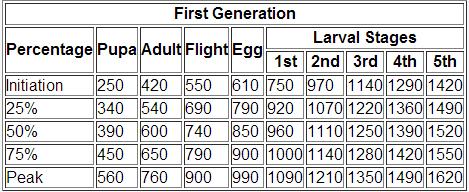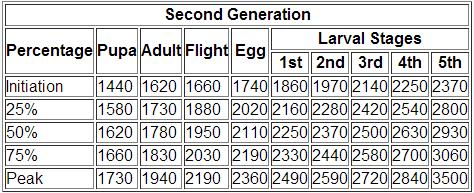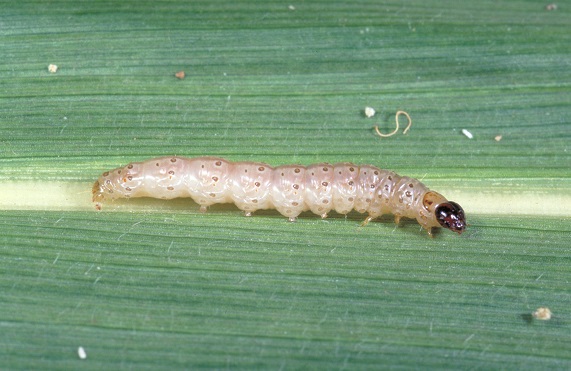Predicting European Corn Borer Development
ENTFACT-106: Predicting European Corn Borer Development | Download PDF
by Ric Bessin, Extension Entomologist
University of Kentucky College of Agriculture
The European corn borer is a serious pest of corn and peppers in Kentucky. Corn borers overwinter as full-grown larvae in corn stubble. With the return of warm weather in the spring, development is resumed and the larvae pupate. Temperature plays a major role in determining the rate of corn borer development. The European corn borer has a 50° to 85°F temperature range at which it is most comfortable. Below 50°F it will not develop, and above 85°F development will slow dramatically.
Figure 1. European corn borer is a key pest of peppers and corn.
The rate of development of European corn borer can be predicted using this relationship. Dr. Grayson Brown at the University of Kentucky developed a degree day model which accurately predicts the occurrence of the different corn borer life stages. It is recommended that these predictions be used in combination with field scouting or pheromone trapping in order to make management decisions. These predictions will alert you to when it is necessary to monitor pheromone traps closely and scout fields for corn borers.
European Corn Borer Development
A degree day for European corn borer is one of degrees above 50°F over a 24-hour period. For example, if the average temperature for a 24-hour period was 70°F, then 20 degree days would have accumulated (70 - 50 = 20) on that day. These accumulations can be used to predict when corn borers will pupate, emerge as adults, lay eggs, and hatch as larvae. With European corn borer, begin accumulating degree days January 1 of each year. Accumulated degree day totals can be compared with the values in the tables below that correspond to various corn borer life history stages. Tables are available for the first and second generation, in some years a third generation may also occur. Values for the third generation are not available. Values corresponding to initiation indicate when the earliest individuals of that stage may appear.
For example, a degree day value of 750 would indicate that nearly 100% of adults have emerged from pupae, of which slightly more than 50% have flown, egg laying has begun, but is less than 25% complete, and that the earliest first instar larvae may be present. This example illustrates the need to compare the accumulated degree day total with values in several columns of the table. During the growing season there is usually a mixture of different stages in a field. Because corn borers emerge at different times, not all corn borers will be in the same stage at any particular time.
Current degree day accumulations are available for European corn borer as well as other insects for many locations in the state through the Agricultural Weather Center maintained by the University of Kentucky Department of Biosystems and Agricultural Engineering.
Up-to-date European corn borer estimates are available through the World Wide Web using the following address "http://wwwagwx.ca.uky.edu/" Click on the ‘Ag/Wx Calculators' to access the insect models.
European Corn Borer Life History Stages


Revised: 11/19
CAUTION! Pesticide recommendations in this publication are registered for use in Kentucky, USA ONLY! The use of some products may not be legal in your state or country. Please check with your local county agent or regulatory official before using any pesticide mentioned in this publication.
Of course, ALWAYS READ AND FOLLOW LABEL DIRECTIONS FOR SAFE USE OF ANY PESTICIDE!
Photos courtesy USDA Insect and Plant Disease Slide Set

